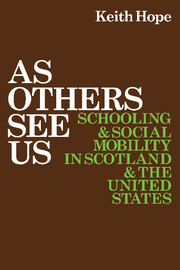Book contents
- Frontmatter
- Contents
- Acknowledgments
- Introduction
- 1 Scotland: A meritelective system?
- 2 Comparison of Scotland with England and Wales
- 3 Comparison of Scotland with the United States
- 4 IQ + effort = merit
- 5 The institutions of managed meritelection
- 6 Was selection carried out fairly?
- 7 Meanings of key terms
- 8 Does deprivation affect life chances?
- 9 Market situation
- 10 Intelligence and occupational mobility
- 11 Intelligence and vertical mobility
- 12 Scottish society
- 13 Understanding other people's norms
- 14 Merit or desert?
- Notes
- References
- Index
11 - Intelligence and vertical mobility
Published online by Cambridge University Press: 05 February 2012
- Frontmatter
- Contents
- Acknowledgments
- Introduction
- 1 Scotland: A meritelective system?
- 2 Comparison of Scotland with England and Wales
- 3 Comparison of Scotland with the United States
- 4 IQ + effort = merit
- 5 The institutions of managed meritelection
- 6 Was selection carried out fairly?
- 7 Meanings of key terms
- 8 Does deprivation affect life chances?
- 9 Market situation
- 10 Intelligence and occupational mobility
- 11 Intelligence and vertical mobility
- 12 Scottish society
- 13 Understanding other people's norms
- 14 Merit or desert?
- Notes
- References
- Index
Summary
In 1961, the late Sir Cyril Burt published a paper entitled “Intelligence and social mobility” that attracted two sorts of criticism. The first came from contemporary sociologists, who treated the model and data of the paper as a contribution to the debate (1) on the heritability of intelligence, and (2) on the role intelligence can play in explaining the flows of men among classes. The second, much later, criticism was voiced by Dorfman (1978), who impugned the data. In fact, a close reading of the paper makes it clear that some of the most important pieces of data were little more than guesswork by the author. Writing (it would appear) before Dorfman's comments were published, Burt's biographer says of this paper:
Although Burt admits “the imperfect nature of the data” he was using, so many assumptions and adjustments were made in the course of his calculations that very little reliance can be placed on his conclusions.
(Hearnshaw, 1979, p. 69; see also Hearnshaw, 1980)It should be clear by now that the Scottish Mental Survey lies at the opposite extreme from Burt's method of assembling data, and so it affords us an opportunity to substitute for his dubious analysis one that is much more securely based. To do this, however, it is necessary to engage in a conceptually more sophisticated exercise than the fairly crude analysis of the preceding chapter.
- Type
- Chapter
- Information
- As Others See UsSchooling and Social Mobility in Scotland and the United States, pp. 202 - 228Publisher: Cambridge University PressPrint publication year: 1985



